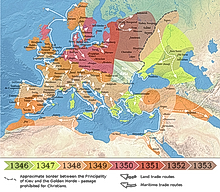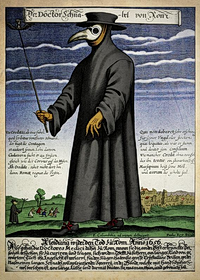Overview

The Black Plague, also known as the Black Death and Bubonic plague was a pandemic that spread across Europe and other parts of the world during the mid-14th century.
This pandemic is estimated to have killed between 75 – 200 million people worldwide, making it one of the deadliest diseases in human history. Today, we have many more tools to prevent and treat infectious diseases, such as vaccinations, antibiotics, and improved sanitation.
Causes of the Pandemic

One of the most common reasons why the Black Plague spread so quickly was due to how society was structured at the time.
Large populations were congregating in unsanitized urban areas and subsequently, this provided a greater opportunity for the disease to be transmitted. How people lived and interacted with each other was also an important factor.
Additionally, poor hygiene and lack of food created an environment in which this illness could easily spread. Things like trade routes and the general migration of people also served as key factors in the transmission of the plague.
Origins of the Black Plague

The plague started in Asia and then quickly spread to Europe via the Silk Road trading route. From there, the disease moved westward, reaching the British Isles in 1348.
It had already spread significantly by the time it was recorded in Western Europe. This is attributed to the large number of rats on ships and in the ports where trade routes were located. Once in Europe, the disease quickly spread throughout the continent.
The culprit was flea bites and as such, it was able to quickly propagate across populations that were near one another.
Symptoms
Because the pandemic was caused by bacteria and not by viruses, it presents distinct symptoms. Early signs of infection include headaches and fevers. The bacteria that caused the plague would then travel to the lymph nodes, causing them to swell and become inflamed.
Once they became inflamed, the bacteria would travel to the blood vessels and create more pustules and buboes (inflammation of the lymph nodes); hence the term Bubonic plague. These would appear as black spots or swellings on the skin.
The bacteria would then travel to the lungs, where it would cause pneumonia and other respiratory symptoms. The buboes would then become large and inflamed, becoming the hallmark of the plague and the most recognizable symptoms.
Treatment

Because no one was aware of what caused this contagion at the time, there was no effective treatment for the disease. The most common way to treat it was through the use of bloodletting.
Bloodletting was a common medical practice at the time that involved the removal of blood from the body. Other methods of treatment included hygiene, isolation, and the burning of clothes.
During this time, many doctors would don black overcoats and beak mask that was filled with substances like lavender, which they believed would keep the plague at a distance.
Social and Economic Effects
The disease had a significant social and economic impact on the world. It caused widespread death and stopped the growth of major cities and towns. This had a significant impact on the social structure of the world at the time.
Cities and towns were forced to close and remain closed. This had an impact on the social aspect of lifestyles during this period. The lack of trade was also a significant factor and trade routes that connected China and Europe were significantly impacted. This had an effect on the economy of the time and how goods were transported and traded.
Long-Term Impact
This bacterial disease led to the creation of quarantine protocols and the early development of modern medicine. It also led to the development of new social and economic systems. There was an increased emphasis on sanitation, hygiene, and the need for better ways of treating patients with infectious diseases.
A new social structure was eventually created. There was a rise in religious groups and new forms of governance. The world was forced to grow in new and different ways.
The End of the Black Plague
It is believed to have ended in Europe around the early 1700s. The exact cause of the end of this pandemic is uncertain, but it is widely believed that there have been multiple factors that contributed to its end.
For example, improved hygiene and sanitation would have reduced the spread. The geographic location and climate of Europe would also have played a role in limiting its spread.
Additionally, developments in modern medicine can’t be ruled out and increased research and development of antibiotics would likely have helped to stop the plague from spreading.
How the Plague Changed History
Trade between major cities was stopped. There was also a significant increase in religious piety and the creation of new religious orders. This led to an increased focus on the afterlife and the creation of new art forms. There was also an increase in the focus on moralistic literature. The Plague also resulted in introduction new methods of modern medical practices. As the pandemic ended, the medical community was able to learn more about the disease and develop new ways of treating it.
Summary
The Black Plague was one of the most devastating pandemics in human history. It caused widespread death and suffering across Europe and beyond, and its effects can still be seen in society today.
The pandemic was caused by a bacterial infection that led to the formation of buboes and pustules on the skin. There was no effective treatment for the disease. It was transmitted via the fleas and body lice of rats.
This contagion quickly spread to major cities and towns and as it prorogated throughout the continents, it caused significant death rates, resulting in a significant social, economic, and long-term impact.
Ironically, the plague changed the course of history by introducing new methods of modern medical practices and advancements in medical science.
